Recently, there has been much interest in biochars as soil amendments to improve and maintain soil fertility and to increase soil carbon sequestration. The capacity to sequester carbon in the soil can be attributed to the relative stable nature and, therefore, long turnover time of biochar in soil and is of particular relevance to the solution of climate change. While it is difficult to estimate how long newly created biochar will stay in the soil some suggest it could be for as long as five thousand years.
Biochar may be an immediate solution to reducing the global impact of farming (and in reducing the impact from all agricultural waste). The burning and natural decomposition of trees and agricultural matter contributes a large amount of CO2 released to the atmosphere. Biochar can store this carbon in the ground, potentially making a significant reduction in atmospheric Greenhouse gas (GHG) levels; at the same time its presence in the earth can improve water quality, increase soil fertility, raise agricultural productivity and reduce pressure on old growth forests.
In specific locations - e.g. at the tropical forest frontier in Central Africa amongst ultra-poor communities of slash-and-burn farmers - biochar may become the kernel of a highly integrated sustainable development and poverty alleviation concept that can tackle key issues simultaneously: hunger and food insecurity, low agricultural productivity and soil depletion, deforestation and biodiversity loss, energy poverty (and related health problems such as indoor air pollution), and climate change. In this concept, multiple mitigation benefits would come from the char in the soil (carbon sink), the avoided deforestation and its associated emissions, and the emissions avoided by making a switch from cooking with unsustainably harvested fuel wood on inefficient open fires to more efficient biochar-generating, small-scale energy production.
As a result of significant product variations due to varying technology, process conditions, and feedstock compositions, biochar cannot be considered a commodity product. Biochar is sold under a range of brand names.
Current biochar projects are small scale, though recent technological developments show that organic matter can be efficiently turned into biochar using advanced pyrolysis processes, potentially making a significant impact on the overall global carbon budget.
How is ‘biochar’ made?
Biochar is made by heating biomass under oxygen-limited conditions (e.g. slow pyrolysis). Feedstock biomass can include forestry and agricultural waste products, municipal greenwaste, biosolids, animal manures, some industrial wastes such as papermill wastes.
Is all biochar the same?
Key chemical and physical properties of biochar are greatly affected both by choice of feedstock and process conditions (mainly temperature, residence time, heating rate and feedstock preparation). These properties affect the interactions of biochar with the environment of its application as well as its fate. There is no rapid screening technique currently available that provides the means for biochar products to be compared or matched to a particular use.
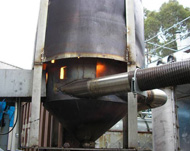
Pilot biochar reactor located at Gosford
What techniques are currently used to characterise biochar?
The chemical structural aspects of biochar can be characterised spectroscopically (e.g. 13C-NMR, ESR, Raman), chemical/thermal analysis (TGA-MS, Py-GCMS) or microscopically (SEM, TEM). Chemical characteristics of biochar can be assessed using standard agricultural soil testing, although some methods require modification. Ecotoxicological testing such as earthworm avoidance assays and plant germination inhibition assays can be used to test the ecological safety of the biochars.
How stable is it?
Studies of charcoal from natural fire and ancient anthropogenic activity indicate millennial-scale stability. However, the stability of modern biochar products is uncertain: it is difficult to establish the half life of newly produced biochar through short term experiments, and aging processes are expected to affect turnover in the longer term. The limited data available suggest that turnover time of newly produced biochar ranges from decades to centuries, depending on feedstock and process conditions. At the moment there is no established method to artificially age biochar and assess likely long term stability.
Is it safe to use?
Prior to the large-scale endorsement of biochar usage, its safe use with regard to human and environmental health needs to be assured. Pyrolysis systems that meet strict emissions standards have been demonstrated. Some biochars have been tested for toxicity, and found to meet guidelines for dioxins, PAHs and heavy metals, The OECD ecotoxicological test involving response of earthworms has demonstrated lack of toxicity of biochar made from paper sludge. Air emissions from biochar production, and composition of the biochar product, are highly dependent on the production systems and the biomass feedstock. Therefore it is critical that the safety of all proposed facilities is assessed Where biochar is used as a soil conditioner it must conform to relevant Australian and international standards and legislation (e.g . the NSW Protection of the Environment Operations (Waste) Regulation). The “earthworm avoidance test”, an ecotoxicological test method prescribed by the OECD, can be used as an initial environmental test. It is a cheap test that is suitable for developing countries.
What are the agronomic benefits?
A number of studies have been conducted where biochar application has shown significant agronomic benefits. However, these results are not universal as other studies have shown no difference, or even some decline, in productivity. The reason lies in the wide range of properties between different biochars, and variation in impact due to interaction with different soil types. Our incomplete understanding of the processes that occur when biochar is applied to soil limits our ability to predict agronomic impacts of biochars in different situations. There is a need for models to allow extrapolation of location-specific findings by accounting for mechanistic effects of variations in soil type, climate, crop species and pyrolysis feedstock.
Is it economically viable?
The economic viability of biochar is dependent on the price of the product and the benefits to the user. The price will be affected by the cost of feedstock (which may be negative in the case of biomass that would incur a waste disposal fee), and returns from renewable energy generated in the pyrolysis process. Financial benefits to the user may include increased production and reduced fertiliser requirements. Furthermore, the biochar producer or user may benefit from some form of carbon credit under an emissions trading scheme: the producer could receive credit for stabilising organic carbon, avoiding emissions from decomposition; alternatively, the landholder may receive credit for increasing the soil carbon stock in his field where biochar is applied. Thus the economic viability of biochar is influenced by policy; uncertainty over future policy may risk investment in biochar production facilities. The growing cost of waste disposal, and implementation of renewable energy targets, are likely to make the production and application of biochar for electricity and waste management economically viable. Potential returns from carbon trading will be enhanced if biochar is accepted under the Clean Development Mechanism (CDM) of the Kyoto Protocol.
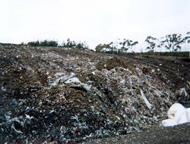
Biochar can help us avoid landfill
What are the environmental and societal benefits?
Models exist for viable agronomic use of biochar in subsistence agriculture. However, appropriate technology and policy needs to be implemented to deal with environmental issues such as methane and particulate emissions, that could contribute to climate change and human health risks. Socio-economic constraints and benefits are not adequately researched. Higher crop yields resulting from biochar applications would be expected to mitigate pressures on land and would also have relevance to land restoration and remediation. Other environmental benefits may include waste re-use and avoided landfill, offset of fossil fuels through renewable energy production, carbon sequestration, potentially reduced soil emissions of non CO2 GHGs, improved crop performance and biomass production.
Source: Australia New Zealand biochar researchers network (ANZBRN)
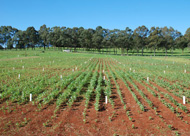
NSW DPI is running the world's largest demonstration of biochar, with over 150 field plots under management.
Video
Watch a 10 minute video about biochar on YouTube featuring NSW DPI researchers. Video...
In the News
- Enriching soil with biochar - ABC'S The Science Show with Robyn Williams, Apr '11
- Opposition supports Biochar research - Jan '09 ABC 7.30 Report
- Solve trading barriers - Dec '08 Ag Today
- Sow good - the potential for biochars - Oct '08 (2SER interview)
- Biochar revolution to benefit climate and agriculture - Sep '08
- Magic biochar: recycles, fertilises and sequesters - Sep '06
Staff
Links
Projects
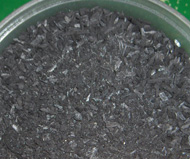
Biochar is made by heating biomass under oxygen-limited conditions.
Land management to increase soil carbon sequestration in NSW
Annette Cowie
Presently, there is considerable uncertainty about the extent of carbon (C) sequestration possible through improved land use and management practices. The improved land use and management practices with significant potential to sequester soil C may, in future, be recognised as eligible for offsets in the NSW Greenhouse Gas Reduction Scheme or its successor. Providing information on potential C sequestration and developing cost-effective and reliable methods of estimating soil C change will assist NSW landholders to take part in emissions trading. If landholders are informed of how land use practices affect soil carbon, they will be better equipped to enhance the productivity and resilience of agricultural and forestry systems.
This collaborative project between the NSW Department of Primary Industries (NSW DPI) and the Department of Environment and Climate Change (DECC) addresses Action 3.6.5 of the NSW Greenhouse Plan. It focuses on developing cost-effective methods for measuring soil C across diverse landscapes and evaluating a range of management practices with potential to promote soil C sequestration in agricultural, pastoral and forests systems in NSW.
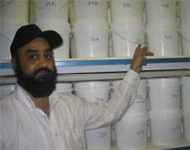
Research Scientist Dr Bhupinderpal Singh with a range of biochars stored in sealed buckets. The biochars are being used in a laboratory incubation experiment to study the turnover of various biochars applied to soil.
The main aims are to:
- develop a rapid and cost-effective method of measuring C across landscapes
- examine the ability of organic amendments to increase soil C stocks
- examine the dynamics of soil C sequestration as a result of land management
changes - assess macro- and micro-scale variability of soil C stocks in diverse landscapes in order to better measure and monitor soil C condition
- contribute experimental data on the C cycle that will improve our understanding of how land management practices influence soil C stocks
- quantify C sequestration potential under different management options on diverse soil systems
- predict soil C sequestration potential at regional and state levels using the C accounting model
- develop land management guidelines that will facilitate better greenhouse outcomes.
Forest Resources Research is leading a subproject that is assessing biochar (a type of charcoal produced from biomass) as an organic amendment in terms of its ability to enhance C sequestration in soil and reduce the amount of greenhouse gases in the atmosphere.
Because the pyrolysis process produces biochar that is expected to provide longterm carbon sequestration in soil, and also generates renewable bioenergy, it is said to be a 'carbon negative' process (it removes more CO2 from the atmosphere than is emitted). To document the extent to which pyrolysis is carbon negative, it is necessary to calculate the whole-of-life greenhouse gas (GHG) balance of the char production and utilisation process, and compare this with conventional practice. In this study we have calculated GHG balance for a range of char feedstocks and two cropping systems. Using published emissions factors, and conservative estimates of biochar-C turnover, we estimated that the reduction in net emissions produced by making and using biochar from dry feedstock was equivalent to 0.5–1.6 times the CO2e (carbon dioxide equivalent) in the feedstock. Not surprisingly, biochar-C turnover rate (the rate at which the carbon in biochar is returned to the atmosphere as carbon dioxide) was one of the major factors affecting the GHG balance of biochar application to soil. However, this is one of the least well-understood properties of
biochar.
To address this question, Dr Bhupinderpal Singh has begun a long-term (up to five years) laboratory incubation experiment examining the time it takes for biochar carbon to be decomposed and released from soil. The study is using a novel method that is based on measuring the inherent difference in C isotope content between biochar and soil. The experiment uses biochar produced from a range of feedstocks and under different process conditions. Early results show decomposition of biochar carbon in soil in the first 84 days varied from <0.1 and 4.7 % of biochar-C applied, depending on the char types tested.
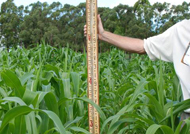
Control corn grew to a height of 1200mm
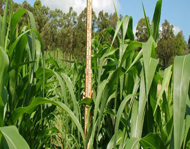
Poultry-litter amended biochar grew to a height of 1900mm at 50t/Ha (35t cob/Ha)
Assessment of Biochar for agronomic benefits, improved fertiliser use efficiency, greenhouse gas abatement, and reduced off-site migration of chemicals.
Lukas Van Zwieten
There is growing interest worldwide in the use of biochar as a soil amendment. Slow pyrolysis for biochar production has multiple benefits including waste management, renewable energy production, climate change mitigation and adaptation, and agricultural productivity.
NSW DPI is collaborating with Richmond Landcare Inc through support from the National Landcare Program. Field trials have been established in a commercial sugarcane property, a newly established macadamia orchard, as well as at Wollongbar Primary Industries Institute on mixed cropping and pasture. Over 120 field plots are under management with this work. We are testing the benefits of a range of biochars (poultry litter, greenwaste, papermill waste, cattle feedlot wastes) on soil properties, agronomic performance emissions of greenhouse gases (CO2, N2O and CH4) from soil and leaching of nutrients. The work holds particular significance for its potential to rehabilitate degraded soils, low nutrient soils, compacted soils etc. Biometrical analysis has shown significant benefits of some biochars on corn yield and faba bean yield, and also significant benefits to soil fertility, in particular, available soil P, pH and CEC. Preliminary root structure analysis demonstrated healthier root systems in the biochar plots. Glasshouse trials have shown improved water holding characteristics, reduced tensile strength of soil and improved nutrient availability (Chan, Van Zwieten et al., 2007, Chan et al 2008 unpublished).
In another project collaborative with BEST Energies Australia, and funded through the NSW Climate Action Grant, an additional 20 field plots have been established to test the benefits of biochar on nutrient use efficiency, N cycling and emissions of N2O and CH4 from biochar amended soils. The work is also placing preliminary economic valuations on biochar, based on nutrient content, and gross margin calculations.
Soil carbon sequestration and rehabilitation: Landholders develop, implement and assess biochar
Dr Lukas Van Zwieten
There is growing interest worldwide in the use of biochar as a soil amendment. It has the potential to both sequester C and enhance agricultural productivity. It holds particular significance for its potential to rehabilitate degraded soils. In work undertaken by NSW DPI, biochar significantly improved plant growth. It increased pH in acidic soils, improved water holding characteristics, reduced tensile strength of soil and improved nutrient availability (Chan, Van Zwieten et al., 2007; Chan, Van Zwieten et al 2008). The recalcitrant nature of C in biochar makes it a suitable agricultural amendment with benefits including climate change mitigation and adaptation.
Information is now becoming available on the distribution and nature of carbon in farming systems in the Northern Rivers through results from “Soil carbon assessment and rehabilitation: Landholders develop and implement new practices” funded under the 2007-08 NLP Community Support round. It is clear that soils in the Northern Rivers have potential for increasing stores of carbon in soil. In particular, char (black carbon) in some soils contributes over 25% of the total carbon stores.
The fundamental outcome of this project will be to demonstrate and encourage the uptake of biochar application to sequester carbon in soil-“where it is needed”- to improve sustainability of agricultural industries and mitigate climate change.
Objectives
- To encourage the uptake of technologies that increase and sequester carbon in soil within the Northern Rivers, in particular through the promotion of biochar (AgricharTM) and demonstration of practical methods of application.
- To train members of Richmond Landcare in methods for collection of soil samples to quantify soil carbon for establishing baselines needed in farm-carbon modelling.
- To continue measuring and accounting for greenhouse gas emissions (CO2, N2O, CH4) from farms using the field demonstration sites.
- To continue to implement, test, demonstrate and promote application of biochar for enhancing sustainability, soil health including nutrient cycling, resilience of agricultural systems and climate change mitigation.
- Provide direct economic benefit to agricultural industries in regional Australia from increased yield and fertilizer use efficiency.
- Enhance Catchment health through reduction in nutrient and pesticide run-off.
- Contribute to the Australian Government’s policy agenda on greenhouse action in regional Australia and enhance regional industry on a number of levels: greenhouse, environmental and economic.
Benefits of papermill biochar (Agrichar TM )
Dr Lukas Van Zwieten
This project assessed the characteristics of biochar derived from papermill waste, and the agronomic and potential environmental benefits from applying this biochar to agricultural soils. Biochar was produced using slow pyrolysis of enhanced solids reduction sludge, clarifier sludge and waste wood chip from an Australian papermill. The structure of the biochars was highly heterogeneous with a large degree of macro-porosity around 1 to 10 microns. The surface area of the feedstock was increased 50-fold through slow pyrolysis. The biochar had liming values of ca. 30% CaCO3, and carbon contents ca. 50% Calcium mineral agglomerates, detected by scanning electron microscopy (SEM) and energy-dispersive X-ray (EDS), account for the liming effect. Biochar was applied at 10 T ha-1 to two soil types, an acidic red ferrosol and an alkaline calcarosol. The impact of biochar with and without a complete fertiliser was tested in factorial combination. Benefits to soil properties included increased pH in the ferrosol of up to 2 units, significantly increased total soil carbon (between 0.5% and 1%) in both soil types, increased CEC in the ferrosol, and reduced Al availability (from 2cmol (+) kg-1 to <0.1 cmol (+) kg-1). The biochars significantly increased crop growth (measured as height and weight of plants) in the ferrosol: wheat biomass was up to 2.5 times higher when biochar plus fertiliser was compared to fertiliser treatment alone. Results suggest improved fertiliser use efficiency with biochar application, especially in the ferrosol. Earthworms showed preference for biochar-amended soil over control soils. This was particularly evident in the ferrosol where up to 92% of the worms migrated to the biochar-amended soil. The results from this work demonstrate that biochars derived from papermill wastes are valuable soil amendments. This work is currently under review for publication in an international journal.
Current work on papermill biochar is investigating its impact on nutrient cycling in soil, and testing for its capacity to reduce emissions of the potent greenhouse gas nitrous oxide from soil.
Assessment of Biochar in Sugarcane cropping systems
Dr Lukas Van Zwieten
A field trial was established in 2007 in a commercial sugarcane crop in the Tweed valley, northern NSW. A total of 15 plots (30m plot length x 3 rows of cane -per plot) were set up using biometrical design to test benefits of two biochars of soil properties, crop yield, leaching of nutrients, nitrogen cycling and emissions of CH4 and N2O. Preliminary results indicate reduction in emissions of N2O with applications of 10t/ha greenwaste biochar, yield measurements are pending.
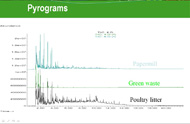
NSW DPI is building a library of research data to develop a predictive tool for the assessment of biochar quality.
Characterisation of Biochar by analytical Py-GC-MS
Dr Lukas Van Zwieten
Py-GC-MS is an analytical technique in which samples are thermally decomposed in an inert atmosphere, followed by identification and quantification of the decomposition products. NSW DPIs Wollongbar facilities have the capability to analyse samples by Thermal Desorption Mass spectroscopy (TD-MS), and flash pyrolysis mass spectroscopy (Py-MS). These two analyses yield different, yet complimentary information.
TD-MS is useful for the identification of bio-oils and more labile components of biochar, which are likely to have immediate influences on soil health and the carbon sequestration potential of biochars when added to soils.
Py-MS provides information on the more recalcitrant forms of carbon in the biochar.
NSW DPI is building a library of archived biochars and similar products, and using these samples and results from research using these biochars to develop a predictive tool for the assessment of biochar quality.
Reduction in N2O emmissions from soils ammended with Biochar
Dr Lukas Van Zwieten
Seven chars produced from feedstocks including papermill waste (1), poultry litter (2) and greenwaste (4) were incubated with a red ferrosol soil under controlled climate conditions. The two litter chars and the papermill char significantly increased the pH of the soil in the incubation experiment. These same chars also had the greatest effect in reducing emission of nitrous oxide from soil. The emissions of nitrous oxide were up to 5 times less than the control soil. These same chars however slightly increased emission of carbon dioxide from the soil.
Overall emissions however clearly showed that nitrous oxide was more significant than emissions of carbon dioxide, due to the multiplying factor used for nitrous oxide (310). The greenwaste chars were less effective in reducing nitrous oxide emission.
All trials were carried out at NSW DPIs Wollongbar Primary Industries Institute. Experiments and analyses are carried out under ISO9001:2000 accreditation. Greenhouse gas analysis was conducted on a dedicated, multi-channel analyser, capable of simultaneous analysis of nitrous oxide, methane, carbon dioxide and carbon monoxide.
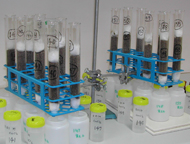
Biochar lab incubation are used for the investigation of a range of biochars in different soils in combination with other organic amendments.
Nitrogen dynamics of biochar in soils
Yin Chan and Simon Eldridge
Based on the limited information available, biochars are very variable in nutrient composition because of the variable feedstocks used and the varying pyrolysis conditions under which they were produced. Therefore, biochars are variable materials and given the very large variabilities of nutrient content, we would expect very different plant and soil responses and therefore very different, currently unpredictable agronomic values of these products as soil amendments. For example, all the biochars are very low in mineral N (<2 mg/kg ) and C/N of the biochars varies widely, between 7-400 with a mean of 61. It is expected application of many of these products to soil will only have limited agronomic values, particularly as direct supplier of N to plants.
Current research aims to improve the understanding of nitrogen dynamics (mineralisation and immobilisation reactions) of biochars when applied to soils. Controlled laboratory incubation experiments and nitrogen isotopic studies are used for the investigation of a range of biochars in different soils in combination with other organic amendments. Information from the research will be used to identify more suitable feedstocks and pyrolysis conditions for the production of biochar with higher agronomic values. The research will also help to identify more responsive soils and better strategies for application of biochar to agricultural soils.
Publications
Chan KY, Van Zwieten L, Meszaros I , Downie A, and Joseph S (2007) Agronomic values of greenwaste biochar as a soil amendment. Australian Journal of Soil Research 45(8) 629-634.
Chan KY,Van Zwieten L, Meszaros I, Downie A, and Joseph S (2008) Using poultry litter biochars as soil amendments. Australian Journal of Soil Research 46, 437-444

